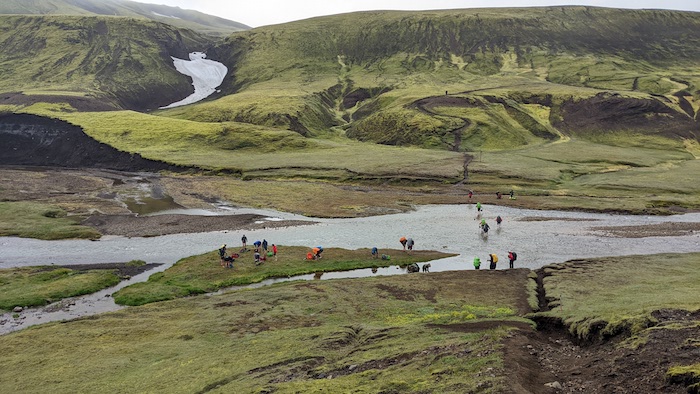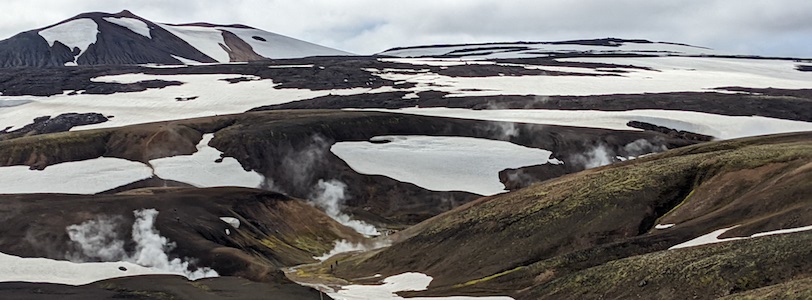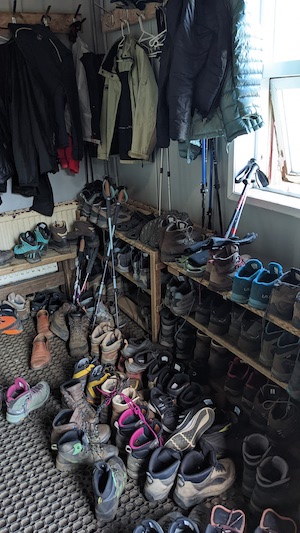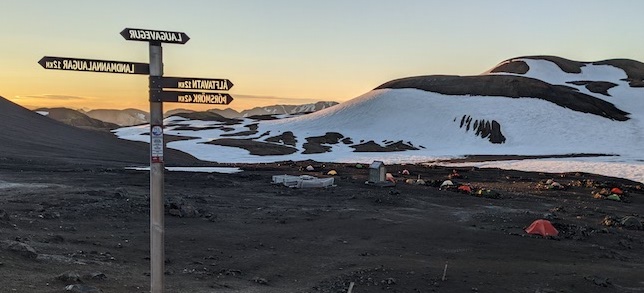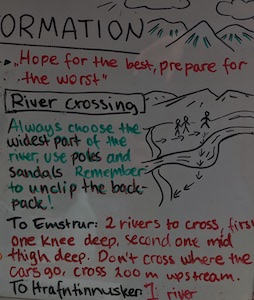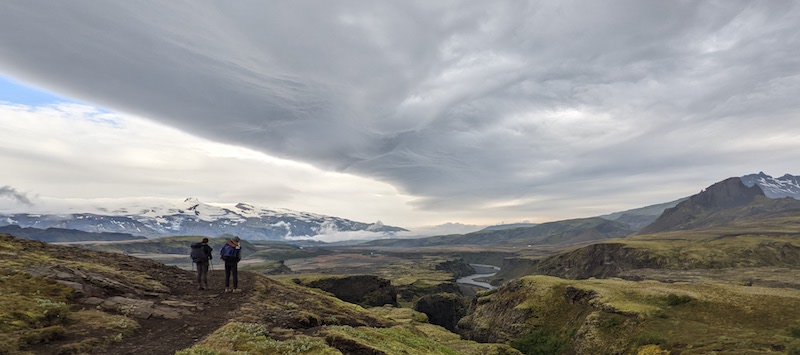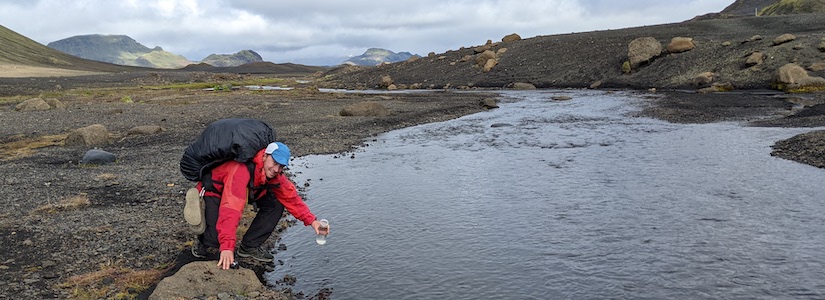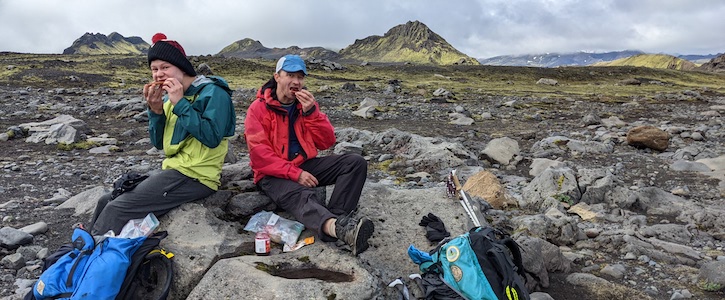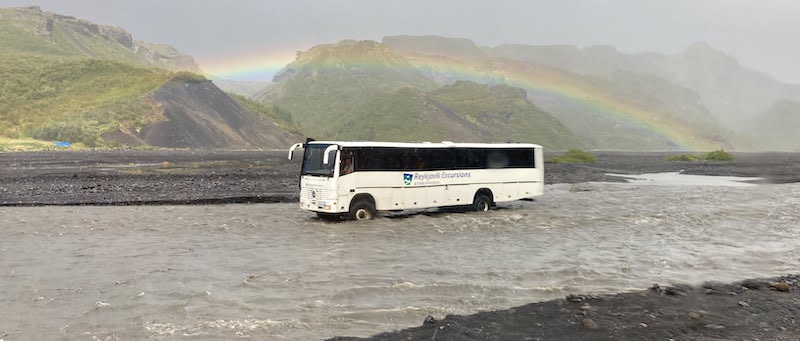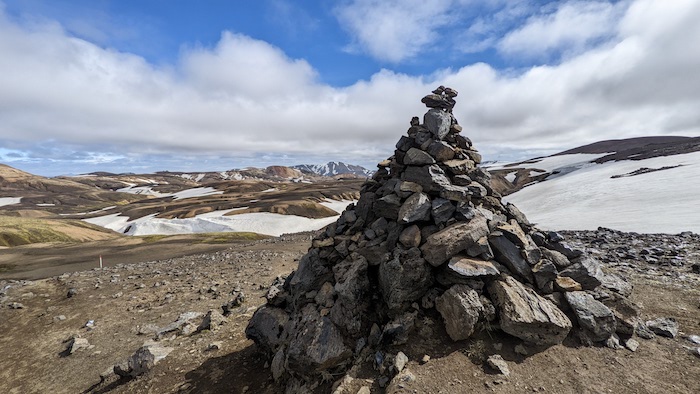Laugavegur Trail - resources, information, and tips you’ll need to tackle Iceland’s best-known long-distance trail.
(This is the first of two posts about the Laugavegur Trail. This one has all the “big picture” information, while the other has day-by-day details, information on river crossings, a packing list, and useful resources.)
If you’re looking for a unique, long-distance hiking adventure with stunning mountain and glacier scenery, the Laugavegur Trail should top your list. In fact, it literally tops the lists as one of National Geographic’s Top 20 “Best Hikes/Epic Trails.”
This 55 kilometer (34 mi) trail cuts through a stunning area of the Icelandic Highlands and is usually completed in four days. Most agree that the challenge level is moderate to high, due more to extreme conditions, terrain, and pack weight than daily distance to cover. However you approach the trail and whatever conditions you experience, you are bound to come away with superlative memories and memory cards packed with photographs of a stunning, remote, and unforgettable landscape.
Is the Laugavegur Trail crowded?
Yes and no. The secret is definitely out, with thousands of hikers from around the world hiking the trail each summer. The starting point at Landmannalaugar can be very crowded, with hundreds of visitors, including day trippers and people who use it as a base to do day hikes from. Once we were out on the trail, however, we rarely had the feeling of a crowd. People set out at different times and hike at different speeds. There is a steady stream of hikers along every part of the trail but they were spread out enough to allow us to have our own space. The only time the trail felt crowded was our last day, when a weather warning had everyone hit the trail at the same time (6am) and hiking quickly to reach the next hut before a downpour hit!
Overview of the Laugavegur Trail
Most people do the trail from north to south due to the overall loss of elevation in that direction. Every day has some climbing, but the biggest is Day 1 with 470m elevation gain to Hrafntinnusker hut.
Day 1: Landmannalaugar to Hrafntinnusker - 12km (7.5 mi)
Day 2: Hrafntinnusker to Alftavatn - 12km (7.5 mi) (or 4km farther to the hut at Hvanngil)
Day 3: Álftavatn to Emstrur - 16km (9 mi) (or 4km less if you chose Hvanngil hut)
Day 4: Emstrur to Þórsmörk - 15km (9 mi)
(Note: the Icelandic alphabet includes several unique characters, with the letter Þ used to make a th sound. Thus, Þórsmörk also appears as Thórsmörk in some publications. It’s the same place!)
For inclement weather, it’s always good to have a map and GPS. With clear visibility throughout our trip, we never had to consult a map since the trail is so well marked. Note: my second blog post with Laugavegur Trail details has details on river crossings and how to best divide the trail into sections, as well as an equipment list and other valuable resources.
Accommodation along the Laugavegur Trail
The two forms of accommodations along the Laugavegur Trail are camping or staying in huts. Each has its pros and cons, but the short answer is, splurge for huts unless you have solid, four-season gear and extensive winter camping experience (more on that below). Huts and campsites are both run by Ferðafélag Íslands, the Icelandic hiker’s association .
Huts along the Laugavegur Trail
Hut accommodations are usually bunkbed arrangements in rooms shared by ten to twenty people. Mattresses are provided, but not pillows, blankets, or sheets. A mid-weight sleeping bag is sufficient since the huts are reasonably warm. There are fully equipped, shared kitchens in every hut, but none serve meals. For us, that meant using larger, heavier packs than we usually use in huts in the Alps, because we carried sleeping bags and food for the entire trail — breakfast, lunch, and dinner, plus emergency spares. The only place where you can pay for a meal is Álftavatn, where a simple meal of canned chile con carne will cost over $30.
Huts are expensive at 11000 ISK per persion per night (about $78). Every hut except Hrafntinnusker offers showers, with hot water available for a fee. The showers at Álftavatn operate on five 100 Króna coins, so make sure you bring the change with you before setting out on the trail. There are no showers in Hrafntinnusker, making a sink wash the only option there. But even that can feel like a luxury after a day on the trail!
Weather forecasts are posted regularly at every hut, as well as basic information on river crossings. Wardens are a reliable source of advice and information on side hikes/view points in the area. All huts sell a small selection of snacks and drinks, though the prices are high — no surprise there.
Camping along the Laugavegur Trail
All but the most hardy hikers choose the hut option, we found. Those who do camp emphasize that a sturdy, four-season tent is a must.
Even if you’re a tough camper, consider the story of our friends who regretted their decision to camp along the trail despite the fact that they’d never had an issue with car-camping in Iceland. They did not expect how much the cold, wet, wind, and heavy gear would wear them down physically and emotionally. Some nights, freezing temperatures kept them from a good night’s sleep. Other nights, it was howling wind buffeting the tents (in some cases, collapsing tents or blowing rain covers away). They endured, but they regretted the choice to camp and recommend huts instead. (In fact, they grabbed the last free spaces in Þórsmörk when the opportunity arose). Those of us who stayed in the huts heartily agree!
If you are determined to camp, note that camping is only permitted in areas adjacent to the huts. The fee is 2500 ISK (about $18) per person per night, with access to drop toilets and outdoor sinks included. Campers may not use any other hut facilities, even after paying the camping fee. That means kitchens and sometimes showers are off limits. The huts at Landmannalaugar and Þórsmörk provide large party-style tents for day use of campers, so you can cook and eat out of the wind and rain.
Reservations
Given how popular the trail is becoming, how early should you reserve a place in the huts? Basically, the earlier, the better. Reservations can be made through Ferðafélag Íslands.
September is the earliest that Ferðafélag Íslands will consider requests for the following summer. We wrote to reserve in September for the following August and were able to secure all the places we wanted for the large group of friends we self-organized. Other hikers reported that some huts were fully booked by January. Consequently, they had to change their dates or combine huts with camping (such as at Emstrur, where the hut also rents tents). Others got around this as late as in May by booking spaces through one of several hiking companies that book contingents ahead of time. The catch was that the rate is double that of booking directly through Ferðafélag Íslands.
It is not necessary to reserve camping spots. Just report to the warden in the hut upon arrival.
Weather along the the Laugavegur Trail
Iceland’s position in the North Atlantic means the weather is extremely changeable. We lucked out with four chilly but dry days with lots of sunshine, with only one rainy day at the end. You never know. The only thing to do is reserve, hope, and check this excellent weather forecast as your departure date nears (note: the website may show an error message outside of summer). Once you’re on the trail, the best source of information are wardens who can help you judge what to expect and how to best tackle each portion of the trail.
One plus is that July and August in Iceland brings 16-19 hours of daylight, so you have some leeway in terms of getting an extra early or late start as dictated by the weather. Long daylight hours also help stave off that instinctual feeling of rushing to get in before dusk.
PRACTICALITIES
Drinking water along the Laugavegur Trail
The one luxury of the Laugavegur Trail is the water — it’s readily available in all huts and can be drunk directly from mountain streams without purification. The only place water isn’t abundant is on day 1 of the trail (the long uphill hike from Landmannalaugar to Hrafntinnusker). Water for showering is also abundant, though some exceptions exist (see huts section). All other beverages are expensive — especially alcoholic drinks!
Food & eating along the Laugavegur Trail
Most hikers pack dehydrated camper’s meals. These are widely available in camp stores in Reykjavik, but at much higher prices than you’ll find at home. So, it makes sense to bring these with you to Iceland. The problem is, Icelandic Customs don’t allow meat imports from North America — not even as one ingredient among many in a dehydrated camper’s meal. We don’t know of anyone whose luggage was checked upon arrival in Iceland, so this may be a moot point. To be on the safe side, passengers arriving from North America could bring vegetarian meals. Passengers arriving from Europe are permitted to import meat, so this is not an issue at all.
For breakfast, we brought instant oatmeal packets from North America, along with granola bars and other snacks. We stocked up on lunch supplies in a Reykjavik supermarket, where you’ll find items like long-lasting pumpernickel bread, cheese, smoked sausage, jam, and so on.
Note: Hikers are expected to carry out any trash they generate, such as food packaging. However, we found trash bins offered at Landmannalaugur, Alftavatn, and Thorsmörk.
Bus access to the Laugavegur Trail
Reykjavik Excursions runs a Highland Bus service that will take you to the start of the trail in Landmannalaugur (a four hour drive from the capital) and bring you back from Þórsmörk (3.5 hours).
Luggage transport along the Laugavegur Trail
It is possible to have luggage transported from hut to hut for a fee, but it’s not as simple as you might think unless you are part of a tour. Luggage transport may be possible through one the the tour companies that runs Laugavegur tours, but your dates have to line up with the tour group’s dates, and they have to have enough room in their vehicle for your bags.
One of our friends spared her bad back using this luggage transport option and offered the following advice: label your bag very securely and clearly with your name, contact number, and most importantly, date for each hut. Also, you should make sure that your bag is truly waterproof (not just water resistant) or that the contents are well protected in waterproof bags.
There are several clusters of huts in Thorsmörk, so you need to make sure they can deliver your bag to the correct hut. Otherwise your bag could wind up a few kilometers away. So, don’t forget to specify which Thorsmörk hut you’re staying in on your bag tag. Southcoast Adventures is one option for luggage transport, charging 10 000 ISK per day (about $70).
Luggage storage while hiking the Laugavegur Trail
Luggage lockers runs luggage storage units in Keflavik Airport, BSI bus station in Reykjavik, and other locations. Those are very convenient options for leaving luggage you won’t need on the trail. There’s just one catch — the 96 hour limit. One solution may be to call ahead to ask if they are willing to let you leave your belongings longer. This worked for us, but it may not always be possible.
Most hotels/hostels in Reykjavik offer free luggage storage for up to a week. However, they don’t take responsibility for lost/stolen items, and other guests will have access to the storage area while you’re away.
So, that winds up the big picture items about hiking the Laugavegur Trail. You’ll find a wealth of details in this second post, including day-by-day descriptions, information on river crossings, a packing list, and other helpful resources. You can also listen to my interview on the Trails Worth Hiking Podcast about our experienes on the trail. I hope both posts are helpful and interesting, either as planning tools or armchair adventures. Happy travels!
